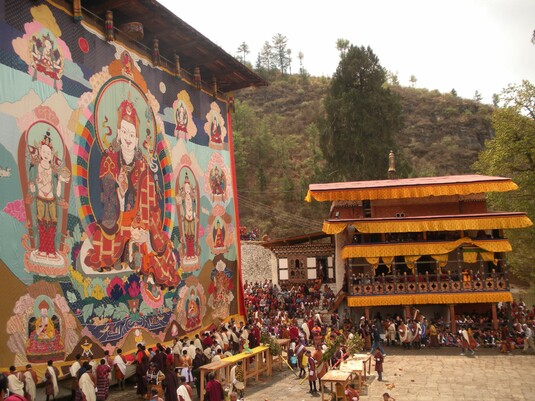
Item: Architecture
| Origin Location | Bhutan |
|---|---|
| Collection | Ariana Maki Photographic Archive |
Classification: Object/Concept
Deyankha; location: Paro Rinpung Dzong, Hungrel gewog, Paro district. The Paro Tshechu is one of the oldest in Bhutan, dating to the time of the Fourth Druk Desi Tenzin Rabgye ('brug sde srid 04 bstan 'dzin rab rgyas, 1638-1696, r. 1680-1695). After a catastrophic fire in 1906 that razed Paro Rinpung Dzong nearly to the ground, Paro governor Dawa Penjore constructed a new building for festival celebrations (tsechu) named Deyankha. The Paro Thongdrol (mthong grol) is a large applique thangka displayed to the public during the annual Paro festival (tsechu). A thongdrol, which means 'liberation on sight,' is revealed in order to confer blessings on those assembled. The Paro thongdrol is brought out of Rinpung Dzong at approximately 3 am in a chibdrel (ceremonial procession) on the last day of the Paro festival, the 15th day of the second Bhutanese lunar month. The main image is of Guru Rinpoche, flanked by his two consorts Mandarava and Yeshe Tsogyal. On the far left and right are the Guru's eight primary manifestations, and the top center is occupied by the three long life deities, Buddha Amitabha, Chenrezig (Avalokiteshvara) and Namgyalma (Ushnishavijaya). Below the consorts are the figures of Zhabdrung Ngawang Namgyal (zhabs drung ngag dbang rnam rgyal, 1594-1651), the founder of modern Bhutan, and Drakpa Gyatso, who is credited with overseeing the making the thongdrel. For more information on Paro Tsechu and Paro Rinpung Dzong, see Dasho Sangay Dorji, "A History of Paro Rinpung Dzong" in Indigenous Facts of Bhutan: Proceedings of the Third Colloquium on the Tangible and Intangible Culture of Bhutan, 11-55, 2009.
Ariana Maki 3-2012
Textile: Giant Applique Textiles
Textile: Applique Artwork Main Page
Bhutan: Miscellaneous 2 (A. Maki Archive)
Textile: Main Page
